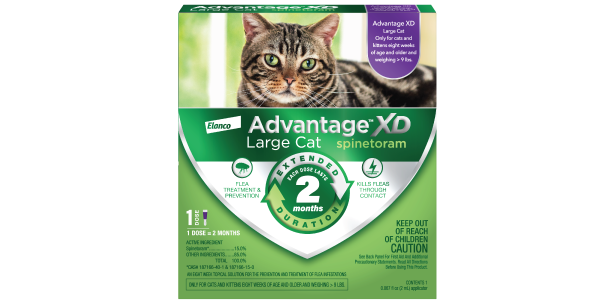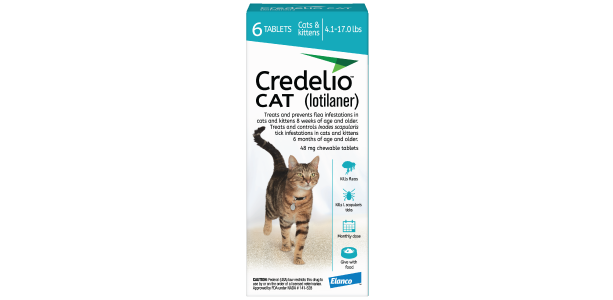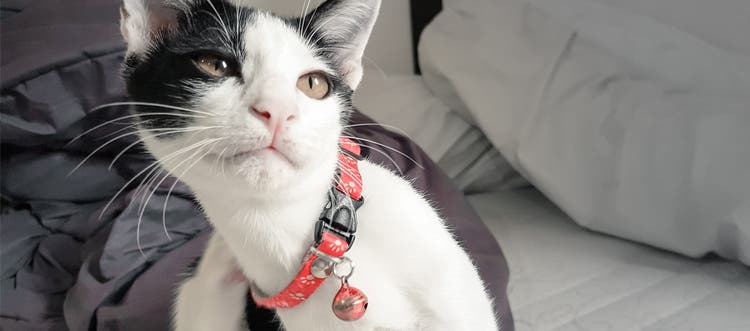Learn how to tell if your cat has FAD.
Cats love to self-groom. You'll often find them cleaning themselves for what seems like hours on end. But sometimes when your cat compulsively licks and scratches at their skin, it could be a sign of a problem.
If your cat's constant grooming causes scratches and lesions on their skin, it's time to talk to your vet, as this could be a sign of flea allergy dermatitis. Did you know your cat could be allergic to fleas?
What Is Flea Allergy Dermatitis?
This condition, also known as FAD or flea bite hypersensitivity, is an allergy to the saliva injected into your pet's skin when a flea bites them. While flea bites can be annoying, irritating and even painful for all cats, pets with FAD can suffer from extreme skin irritation and itchiness with only a few flea bites that set off a chain reaction under the skin.
How Do I Know If My Cat Has Flea Allergy Dermatitis?
If your cat has FAD, they won't just scratch occasionally - they'll likely experience severe discomfort and constantly try to calm their skin by grooming it. Unfortunately, that overzealous grooming usually makes the condition worse, especially if your cat has sharp claws. Symptoms to look for include:
- Raw, irritated skin
- Patchy or uneven hair loss, sometimes around open sores
- Bald spots around the belly or inner legs
- Small lesions or scabs that look like pimples on the face, neck and back
- Nonstop itching, biting, clawing or grooming
My Cat Has Flea Allergy Dermatitis Symptoms, So Why Can't I Find Fleas on Them?
Because cats are so meticulous, it can be difficult to find fleas or flea dirt on them. And because animals with FAD may experience a severe reaction after only a few flea bites, it can be even more difficult to find the source of the problem. Look for fleas or flea dirt around your cat's face and neck, where they can't groom as thoroughly. Or bring your cat to the vet for a closer inspection to determine if FAD is the cause of your cat's discomfort.
How Can I Soothe Flea Allergy Dermatitis?
Your veterinarian has topical, oral and injectable treatments to help ease the itch. Because the constant itching and clawing can cause infections, your vet may discuss using antibiotics to treat those issues as well. For a cat that's not water-averse, a cool bath at home can also temporarily soothe the skin.
How Long Does Flea Allergy Dermatitis Last?
If fleas continue to bite your allergic cat, your pet will likely experience discomfort until the fleas are treated. During that time, secondary skin issues from clawing and scratching - including open sores and skin lesions - often occur. Unfortunately, a cat with FAD will most likely be sensitive to flea bites throughout their life, but you can help keep these flare-ups at bay by preventing the flea infestations that cause them.
How Can I Prevent Fleas That Trigger FAD on My Cat?
Flea treatment and prevention products are key to helping stop FAD from becoming an ongoing issue. Even if your cat doesn't have FAD, it's important to actively try to prevent fleas, since flea bacteria causes Bartonella, a disease that can lead to serious illnesses such as heart disease and seizures. Flea ingestion can also cause tapeworms, which can lead to intestinal issues. By staying vigilant with regular preventive flea treatments, you can help prevent annoying, biting fleas that infest your cat and make them miserable.

Advantage® XD (spinetoram)
Kills fleas for two months with one dose, outlasting the typical six-week flea life cycle — and the monthly competition.

Credelio® CAT (lotilaner)
Protect your feline friend with Credelio Cat, the first and only flea and tick chewable for cats.

Seresto® Flea & Tick Collar for Cats
An easy-to-use, odorless, non-greasy collar that kills and repels fleas and ticks for 8 continuous months.

Advantage® II for Cats
A convenient, monthly topical application that kills fleas through contact so they don't have to bite your cat to die.
Credelio® CAT (lotilaner)
Indications:
Credelio CAT kills adult fleas and is indicated for the treatment and prevention of flea infestations for one month in cats and kittens 8 weeks of age and older and weighing 2 pounds or greater.
Credelio CAT is also indicated for treatment and control of black-legged tick infestations for one month in cats and kittens 6 months of age and older and weighing 2 pounds or greater.
Important Safety Information:
Lotilaner is a member of the isoxazoline class of drugs. This class has been associated with neurologic adverse reactions including tremors, incoordination, and seizures. Neurologic adverse reactions have been reported in cats receiving isoxazoline class drugs, even in cats without a history of neurologic disorders. Use with caution in cats with a history of neurologic disorders. The safety of Credelio CAT has not been established in breeding, pregnant and lactating cats. The effectiveness of Credelio CAT against black-legged ticks in kittens less than 6 months of age has not been evaluated. The most frequently reported adverse reactions are weight loss, rapid breathing and vomiting. For complete safety information, please see Credelio CAT product label or ask your veterinarian.


